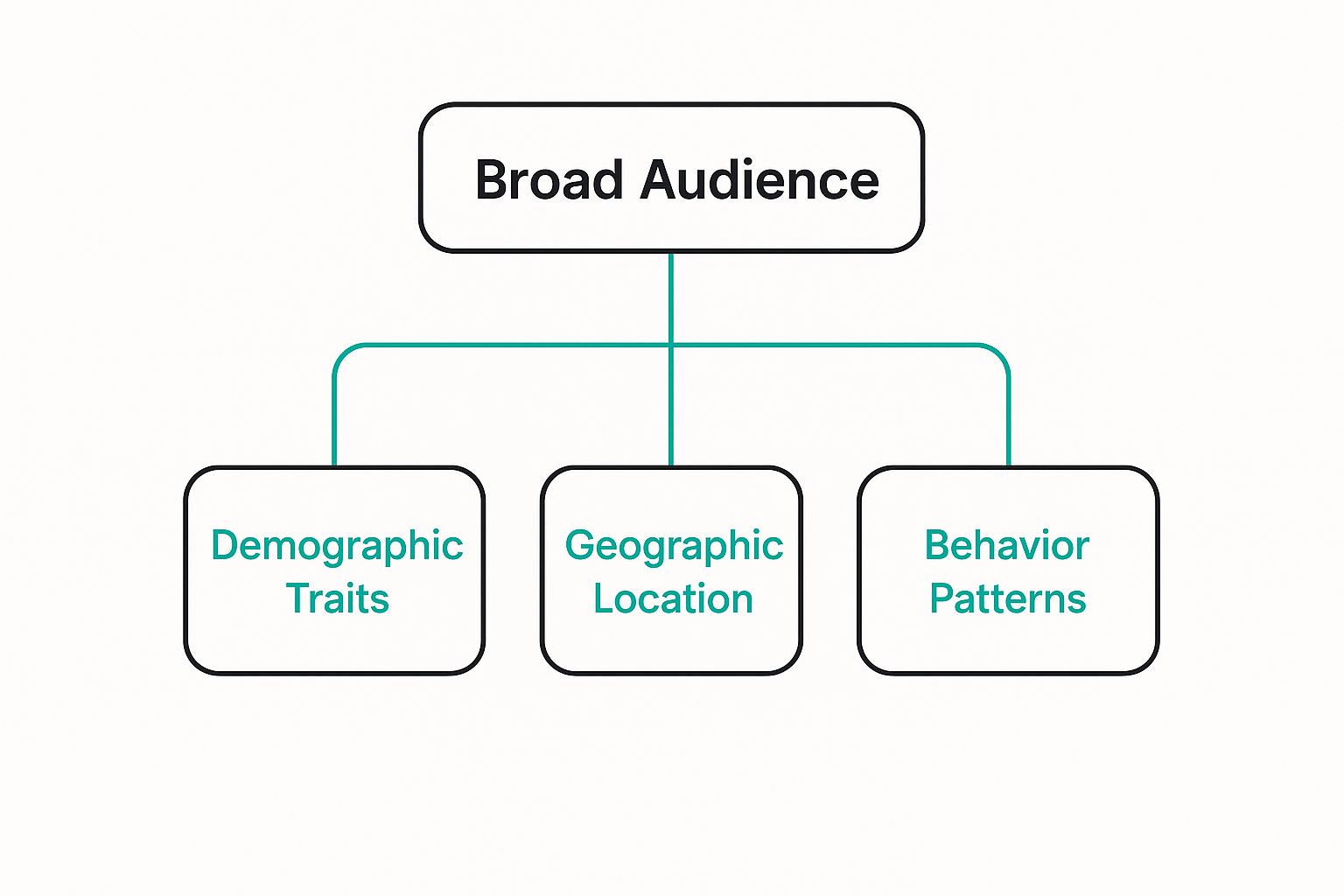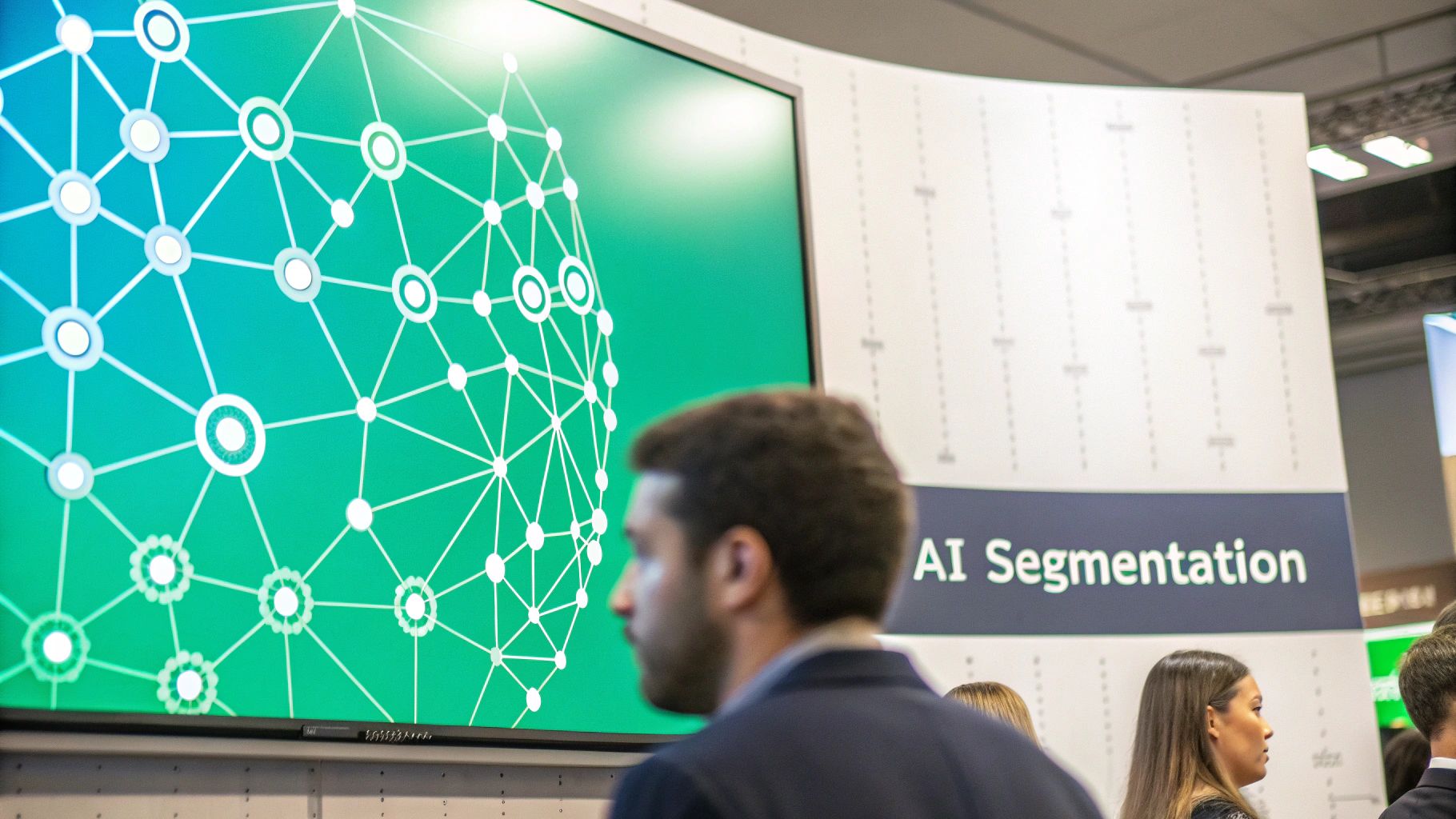What Is Audience Segmentation and How It Works
Audience segmentation is really just a fancy term for a simple, powerful idea: dividing your broad audience into smaller, more focused groups based on what they have in common. Instead of blasting the same generic message to everyone, you get to speak to people about what actually matters to them. It’s the difference between shouting into a packed stadium and having a real conversation.
Moving Beyond One-Size-Fits-All Marketing
Imagine trying to sell snow coats in the desert. Or pitching retirement plans to a bunch of teenagers. That’s pretty much what marketing without segmentation feels like—you're just throwing messages out there, hoping something sticks. In a world where everyone expects a personal touch, that old one-size-fits-all approach isn’t just inefficient; it’s a guaranteed way to get ignored.
The logic behind audience segmentation is straightforward. You take your entire audience and break it down into distinct groups, or segments. These segments are built around shared traits, which lets you create targeted campaigns that speak directly to their specific needs, interests, and pain points.
This is a great way to visualize how a broad audience can be broken down using just a few key attributes.

As you can see, you can start separating a large, undefined group into more focused segments by looking at their demographics, location, and behaviors. It's the first step toward smarter marketing.
Why Generic Messages No Longer Work
People are bombarded with thousands of marketing messages every single day. To cut through that noise, your message has to be incredibly relevant. Generic outreach feels impersonal and gets deleted on sight, which is a big reason so many marketers are asking why cold outreach doesn’t work anymore and looking for something better.
When you understand what makes each segment tick, you can craft messages that resonate on a much deeper level. This small shift turns your marketing from an annoying interruption into a genuinely helpful conversation. To get a handle on the core concepts, it's worth exploring the fundamentals of audience segmentation to see how the process works from the ground up.
The Strategic Shift to Smarter Engagement
Bringing audience segmentation into your strategy is more than just a new marketing tactic; it’s a complete shift in how you see and interact with your customers. It forces you to listen first, then act. Instead of guessing what your entire audience wants, you’re using real data to make informed decisions.
This strategic approach ensures that your marketing budget is spent more effectively, your team's efforts are focused on high-impact activities, and your customers feel understood and valued.
Ultimately, segmentation builds stronger relationships and paves the way for sustainable growth. The benefits are pretty clear:
- Improved Conversion Rates: Sending the right message to the right person at the right time just naturally leads to more conversions.
- Enhanced Customer Loyalty: When customers feel like a brand "gets" them and their individual needs, they’re far more likely to stick around.
- Better ROI: Focusing your resources on the most promising segments means less wasted ad spend and a much higher return on your marketing investment.
- Informed Product Development: Insights from different segments can shine a light on unmet needs or opportunities for new products and features you hadn't considered.
The Four Pillars of Audience Segmentation

To really get what audience segmentation is all about, you need to understand its four foundational pillars. Think of them as different lenses you can use to look at your audience. Each one reveals unique details about who they are and what they need.
By combining these perspectives, you can move from a blurry, one-dimensional view of your customers to a rich, multi-faceted understanding. These four pillars are Demographic, Geographic, Psychographic, and Behavioral segmentation. Let's dig into each one and see how they work in the real world.
Demographic Segmentation: The Who
Demographic segmentation is usually the first stop on the journey because it’s the most straightforward. It answers the fundamental question: Who is my audience? This pillar groups people based on objective, statistical, and factual data.
This data is powerful because it's quantifiable and relatively easy to get your hands on. It gives you a solid, factual starting point for understanding who makes up your customer base.
Key demographic variables include:
- Age: Are you talking to Gen Z, Millennials, or Baby Boomers?
- Gender: Does your product resonate more with men, women, or a non-binary audience?
- Income: Are your customers high-earners or more budget-conscious shoppers?
- Education Level: Do they have a high school diploma, a college degree, or something more advanced?
- Occupation: Are they students, tech professionals, healthcare workers, or retirees?
- Marital Status: Are they single, married, or in a long-term partnership?
A skincare brand, for instance, might use this data to create totally different campaigns. One could target women aged 18-24 with messaging about acne solutions, while another targets women aged 45-60 with products focused on anti-aging. The product might be similar, but the messaging, visuals, and benefits are completely different because the "who" is different.
Geographic Segmentation: The Where
Next up is geographic segmentation, which zeroes in on where your audience is located. This might sound simple, but location has a huge impact on a person's needs, culture, and buying habits. It’s about more than just a country or a city.
This approach is crucial for everyone, from the local corner shop to the global corporation. It makes sure your marketing is actually relevant to the environment your customers live in.
Geographic segmentation allows you to tailor your message based on regional nuances like climate, local culture, and language, making your brand feel more local and relatable.
Consider these geographic factors:
- Country, State, or City: Targeting at a macro or micro level.
- Climate: Selling parkas in Miami is probably not your best move.
- Urban vs. Rural: City dwellers and people in rural areas often have vastly different needs and lifestyles.
- Language: Speaking to customers in their native language is a non-negotiable for building trust.
A clothing retailer is a perfect example. They’d use geographic data to push swimsuits and shorts to customers in Southern California in March, while at the same time marketing heavy coats and snow boots to people in New England. It’s a practical way of understanding "where" your audience is and what their location says about their immediate needs.
Psychographic Segmentation: The Why
While demographics tell you who your audience is, psychographics explain why they do what they do. This is where segmentation gets really interesting—and powerful. Psychographic segmentation groups people based on their internal characteristics, like their beliefs, values, attitudes, and lifestyles.
This pillar helps you connect with your audience on a much deeper, more emotional level. It’s all about getting to the heart of their motivations and what truly drives their decisions. You can uncover this kind of information through surveys, customer interviews, and by analyzing social media behavior.
Psychographic data includes:
- Lifestyle: Are they urban adventurers, cozy homebodies, or dedicated fitness enthusiasts?
- Values: Do they prioritize sustainability, family, or career success above all else?
- Interests and Hobbies: What do they love to do in their free time? Are they gamers, gardeners, or globetrotters?
- Personality Traits: Are they analytical, creative, outgoing, or introverted?
Imagine a wellness company that sells organic, eco-friendly products. They could use psychographic segmentation to target consumers who value sustainability. Their messaging wouldn't just talk about the product's features; it would talk about a shared belief in protecting the planet. That kind of connection creates a bond that’s much stronger than a simple transaction.
Behavioral Segmentation: The How
Finally, we have behavioral segmentation, which is arguably the most actionable of the four pillars. It groups customers based on their direct interactions with your brand—how they behave. This data is based on observed actions, not what people say they'll do, which makes it incredibly reliable.
Behavioral data shows you what people are actually doing. This lets you respond directly to their actions with timely and relevant offers that feel personal.
Here’s a breakdown of common behavioral segments:
| Behavior Type | Description | Example Application |
|---|---|---|
| Purchase History | Groups customers by what they buy, how often they buy, and how much they spend. | An e-commerce store sends a special discount to customers who have spent over $500 in the last year. |
| Engagement Level | Segments users based on their interaction with your website, app, or emails. | A software company offers a personalized demo to users who have visited the pricing page three times. |
| Benefit Sought | Groups customers by the specific value or benefit they are looking for. | A car brand targets one segment with safety features and another with ads focused on performance. |
| Customer Loyalty | Differentiates between new visitors, repeat customers, and loyal brand advocates. | A coffee shop creates a loyalty program that rewards frequent buyers with free drinks and exclusive offers. |
By understanding these behaviors, you can create highly personalized experiences. An online store can spot a first-time visitor and offer them a 10% welcome discount, while sending a "we miss you" campaign to customers who haven't bought anything in six months. This is what makes audience segmentation such a powerful tool for driving real results.
Real-World Benefits of Segmenting Your Audience

It’s one thing to understand the theory behind segmenting an audience, but it’s another thing entirely to see what it does in the real world. When you move from concept to practice, it becomes clear that audience segmentation isn't just a neat way to organize contacts—it's a serious driver of business growth.
The moment you stop yelling into the void with a single, generic message and start talking to specific groups of people, everything changes. The core benefit is a massive jump in relevance. Your messages land better because they're designed for the person receiving them, which makes customers feel seen and understood.
Turning Browsers into Buyers with Higher Conversions
One of the first and most obvious wins you’ll see from segmentation is a jump in your conversion rates. It just makes sense. When a potential customer gets a message that speaks directly to their problem or interest, they're far more likely to click, sign up, or buy.
Relevance cuts through the noise and removes friction. Think about it: a first-time visitor to your site needs a completely different experience than a loyal customer who's bought from you ten times. By segmenting them, you can roll out the welcome mat for the newcomer with a special offer while showing your veteran customer exclusive new arrivals.
This isn't a "nice-to-have" anymore; customers expect it. And the numbers don't lie. A huge 81% of consumers say they're more likely to buy from brands that offer personalized experiences. Companies that get this right see an eye-popping 760% increase in email revenue, and 77% of marketing ROI comes straight from segmented, targeted campaigns. If you want to dive deeper, you can discover more insights about audience segmentation strategies.
Fostering Deeper Connections and Customer Loyalty
Beyond that first sale, segmentation is your best tool for building relationships that last. When customers feel like a brand just gets them, they stick around. Consistently delivering content and offers that align with their needs builds a foundation of trust that keeps them from wandering off to a competitor.
For example, a segment of your high-spending, frequent buyers might get early access to new products or an invitation to a VIP event. At the same time, you could create a "we miss you" campaign for customers who haven't purchased in a while, giving them a gentle nudge to come back.
By speaking to customers based on their history and behavior with your brand, you transform a transactional relationship into a relational one, turning one-time buyers into lifelong brand advocates.
Achieving a Stronger Return on Investment
Finally, let's talk about your budget. Audience segmentation makes every marketing dollar you spend work harder. Mass marketing is like casting a huge, expensive net and hoping you catch the right kind of fish. Segmentation is like using the perfect lure to attract exactly the fish you want.
You stop wasting money shouting at people who were never going to listen anyway. By focusing your time, effort, and ad spend on the groups most likely to convert, you get a much higher and more predictable return on your investment. It allows you to:
- Allocate budget effectively: Put more resources behind your most profitable customer segments.
- Optimize campaign performance: Run A/B tests on different segments to see which messages hit home.
- Improve product development: Use feedback from specific groups to guide new features or products.
This strategic focus proves that knowing your audience isn't just good marketing—it's just plain smart business.
Your Step-by-Step Guide to Implementing Segmentation
Knowing what audience segmentation is and why it matters is half the battle. Now, it’s time to actually put that knowledge to work. This guide will walk you through the process of building and launching a segmentation strategy, taking you from theory to tangible results.
Think of it like building a custom map. Instead of using a generic world atlas, you're creating a detailed guide to your specific customer landscape, complete with landmarks, popular routes, and hidden gems. Let's get started.
Step 1: Set Clear Business Goals
Before you even think about touching your data, you need to know what you're trying to accomplish. What does success actually look like for your business? Without a clear destination, you’re just wandering through customer analytics. Your goals are the compass for your entire segmentation strategy.
Start by asking some specific questions. Are you trying to:
- Increase the conversion rate for first-time visitors?
- Reduce churn among existing customers?
- Boost the average order value from your most loyal segment?
- Improve lead quality for your sales team?
Having a concrete objective, like "increase repeat purchases by 15% in the next quarter," gives you the focus you need to build meaningful segments. This clarity ensures you're not just grouping customers for the sake of it, but to drive specific, measurable outcomes.
Step 2: Gather and Analyze Customer Data
With your goals locked in, it's time to gather your raw materials—customer data. This is where you'll find the insights needed to form your segments. The good news is, you probably already have access to a ton of information from various places.
You can find valuable data in a few key places:
- CRM Software: Your Customer Relationship Management system is a goldmine of demographic info and purchase history.
- Website Analytics: Tools like Google Analytics show you behavioral data—how users actually interact with your site.
- Customer Surveys: Sometimes, the best way to get answers is to just ask. Surveys give you rich psychographic insights into goals and pain points.
- Social Media Insights: Your social platforms offer analytics on follower demographics and engagement patterns.
This step is becoming more critical every year. The global audience analytics market was valued at USD 5,002.1 million in 2024 and is projected to nearly double to USD 9,962.6 million by 2030. It’s the large enterprises leading the charge, which shows that investing in solid data collection pays off.
Step 3: Choose Your Segmentation Models
Okay, you have your data. Now you have to decide how you’re going to slice it up. Go back to those four main types of segmentation—demographic, geographic, psychographic, and behavioral—and pick the models that actually line up with your business goals.
For instance, if your goal is to get more local foot traffic, geographic segmentation is a no-brainer. If you’re launching a luxury product, combining demographic data (like income level) with psychographic data (like lifestyle and values) will be your best bet. The most powerful strategies usually mix and match, layering different models to create super-specific and useful segments.
The key is to avoid creating segments that are too broad (e.g., "all women") or so narrow they're useless (e.g., "left-handed software developers in Idaho who own a cat"). Your segments need to be big enough to matter but specific enough to be relevant.
A B2B company, for example, could combine firmographic data (company size, industry) with behavioral data (website pages visited) to spot high-intent prospects. For more ideas on targeting business clients effectively, check out our beginner's guide to B2B lead generation.
Step 4: Build and Activate Your Segments
This is where your strategy finally comes to life. Using your chosen models and data, you can now build out your distinct audience segments. A lot of marketing automation platforms and CRMs have built-in tools that make this part pretty straightforward.
You might even create customer personas for your key segments. Give them names and personalities—it really helps your team understand who they're talking to.
Tools like Google Analytics let you create custom audience segments based on user attributes and behaviors right inside the platform.
Once they’re built, it’s time for activation. This means tailoring your marketing efforts—from ad copy and email campaigns to website content—for each specific group. If you want to get really granular with email marketing, exploring how to segment email lists can give you some great channel-specific tactics.
Step 5: Test, Refine, and Iterate
Audience segmentation isn't a "set it and forget it" task. Customer behaviors change, markets shift, and your own business evolves. Your segments have to adapt, too. The final step is to keep a close eye on the performance of your segmented campaigns and tweak your approach based on what you see.
Track key metrics for each segment. Are your messages hitting the mark? Are conversion rates going up? Use A/B testing to experiment with different offers, headlines, and calls to action for each group. This cycle of testing and learning is what ensures your segmentation strategy stays sharp and continues to deliver a strong ROI over time.
How AI Is Changing the Game in Audience Segmentation
 The future of understanding your customers is already here, and it’s powered by artificial intelligence. While traditional segmentation methods still work, AI and machine learning are taking the practice to a whole new level. We're moving away from static groups and into the world of dynamic, intelligent targeting.
The future of understanding your customers is already here, and it’s powered by artificial intelligence. While traditional segmentation methods still work, AI and machine learning are taking the practice to a whole new level. We're moving away from static groups and into the world of dynamic, intelligent targeting.
Think of a human marketing team as skilled detectives, piecing together clues from customer data to identify different groups. AI, on the other hand, is like having a supercomputer that analyzes every single clue from millions of sources at once. It sees connections and patterns that are completely invisible to the human eye.
This allows businesses to stop looking only at historical data and start predicting what customers will do next. It’s a huge leap forward, making marketing more efficient, effective, and deeply focused on the customer.
Uncovering Hidden Patterns with Predictive Analytics
One of the most powerful ways AI helps with segmentation is through predictive analytics. AI algorithms sift through enormous datasets—purchase histories, website clicks, social media interactions, you name it—to forecast what customers are likely to do next. This is a game-changer for getting ahead of the curve.
For example, AI can spot a "likely to churn" segment by detecting subtle shifts in behavior long before a customer actively cancels their subscription. This gives you a critical window to jump in and re-engage them with a targeted retention campaign.
Instead of just reacting to what customers do, AI lets you anticipate their needs and meet them ahead of time. This creates a much smoother and more satisfying customer journey.
This shift toward predictive modeling means you can build segments based not just on who customers are, but who they might become. You can explore the complete guide to AI lead generation tools to see how this technology is reshaping customer acquisition.
Making Hyper-Personalization Possible at Scale
The ultimate goal of knowing your audience is to give them a perfectly tailored experience. AI makes this possible on a scale that was once unimaginable. It automates the heavy lifting of creating and managing tiny micro-segments, letting you personalize messages for countless small groups or even individuals.
The financial impact here is undeniable. The global AI marketing market is projected to grow from $20 billion in 2022 to $40 billion by the end of 2025. The broader AI sector is expected to hit nearly $390.9 billion. This growth is fueled by AI's ability to deliver hyper-personalized experiences, a capability that 56% of marketing leaders are actively budgeting for in 2025.
The Rise of Dynamic Segmentation
Perhaps the biggest change AI brings is the move from static to dynamic segmentation. Traditional segments are often fixed and updated only every so often. AI-powered segments, however, can change in real-time based on a customer's latest actions.
Here’s a quick look at how it works:
- A user browses a specific product category on your site.
- AI instantly moves them into a "high-intent for product X" segment.
- The ads they see and the emails they get are immediately updated to reflect this new interest.
This constant adaptation ensures your marketing is always relevant to what the customer is thinking about right now. It’s a much more fluid and responsive approach that treats each customer as an individual on their own unique journey, making your marketing efforts smarter and way more effective.
Common Segmentation Mistakes and How to Avoid Them
Even the best strategies have weak spots, and audience segmentation is no different. Jumping in without a solid plan can lead to a lot of wasted time and confusing results. If you know the common mistakes ahead of time, you can steer clear of them and build a strategy that actually works.
One of the most common traps is over-segmenting. It's easy to get carried away and slice your audience into dozens of tiny, super-specific groups. While it feels precise, you often end up with segments so small they’re impossible to target in a meaningful way. You’ll burn through resources creating unique campaigns for just a handful of people, which almost never pays off.
But the opposite problem is just as bad: under-segmenting. This is what happens when your segments are still too broad to tell you anything useful. Lumping all customers aged 25-50 into one bucket, for instance, completely ignores the huge differences in lifestyle, income, and priorities within that group. A 26-year-old just starting their career has totally different needs than a 48-year-old parent.
The goal of segmentation isn't just to divide your audience. It's to create groups that are different enough—and large enough—to justify a specific marketing approach.
Relying on Stale or Incomplete Data
Another classic mistake is building your whole strategy on old, crusty information. Customer data goes bad quickly; people move, switch jobs, and find new interests. Using outdated data is like trying to find your way with a five-year-old map—you're going to get lost.
This leads to sending the wrong message to the right people, or just missing big opportunities entirely. To fix this, you need to make data hygiene a regular habit. Here are a few ways to keep your information fresh:
- Regularly Clean Your Lists: Get rid of inactive subscribers and update contact details.
- Use Progressive Profiling: Don’t ask for everything at once. Collect more data from customers gradually over time.
- Analyze Recent Behavior: What someone did last week is a much stronger signal than what they did two years ago. Prioritize recent actions like website visits or purchases.
Segmenting Without an Action Plan
Finally, the biggest mistake of all is treating segmentation like some abstract, academic project. Creating beautifully detailed segments is completely pointless if you don't do anything with them. Segmentation without a clear plan for what comes next is just data for data's sake.
Before you even start building a segment, ask yourself this one simple question: "How will we treat this group differently?" If you don’t have a specific action in mind—a targeted email, a personalized ad, a unique content offer—then that segment has no real-world value. Every single segment you create needs a clear purpose that ties directly back to your business goals.
Got Questions About Audience Segmentation?
Even with a solid plan, a few questions always seem to come up when you start digging into audience segmentation. It's completely normal. Let's clear up some of the most common ones so you can feel confident putting this stuff into practice.
What's the Real Difference Between a Target Market and an Audience Segment?
This is a big one, but the distinction is actually pretty simple once you see it.
Think of your target market as the entire crowd at a concert. It's the big, broad group of people you want to reach, defined by general traits. For example, "millennial women interested in sustainable fashion."
An audience segment, however, is like a specific group of friends within that crowd—maybe the ones in the front row. It's a much smaller, more focused group that shares very specific characteristics.
Using our example, you could break down that target market into segments like:
- The High-End Shopper: A group of women with higher incomes who have bought luxury items from you before.
- The First-Time Buyer: People who've browsed your site multiple times but haven't pulled the trigger on a purchase yet.
Your target market tells you who you're generally trying to reach. Audience segmentation tells you how to talk to specific groups within that market so your message actually connects.
What Are the Best Tools for Audience Segmentation?
You don't need a huge budget to get started. There are plenty of powerful tools out there, from free essentials to more advanced platforms.
- Google Analytics: This is a fantastic free starting point. It's packed with behavioral and demographic data from your website visitors.
- CRM Software (e.g., HubSpot): Your CRM is a goldmine. It tracks purchase history, customer interactions, and personal details that are perfect for segmentation.
- Customer Data Platforms (CDPs): These are more advanced tools that pull customer data from all your sources into one place. This gives you a single, unified view for really deep and accurate segmentation.
How Often Should I Update My Segments?
Audience segmentation isn't a "set it and forget it" kind of task. People change. Their habits, needs, and preferences evolve, and your segments need to keep up.
A good rule of thumb is to review your segments at least quarterly. But stay flexible. If you see a big shift in your campaign performance or a new trend takes off in your market, you might need to adjust them sooner. Keeping your data fresh is what makes sure your strategy stays sharp and effective.
Ready to stop guessing and start finding high-intent leads? Intently uses AI to monitor online conversations on platforms like Reddit and LinkedIn, delivering real-time alerts when potential customers are talking about their needs. Find qualified leads who are actively looking for solutions like yours. Learn more at https://intently.ai.
